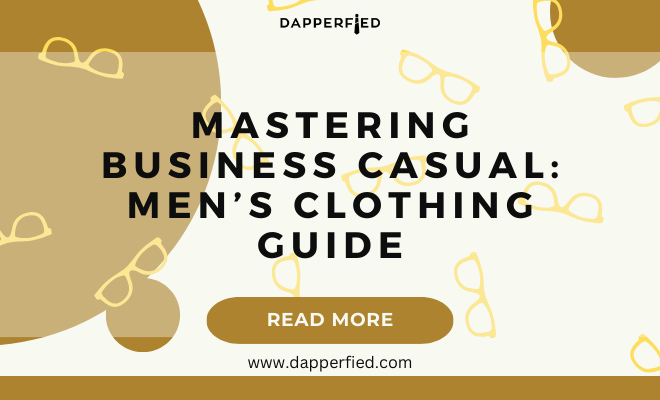
Men's Style
Mastering Business Casual: Men’s Clothing Guide
Business casual attire is a dress code that many companies and organizations have adopted in recent years. It is a more relaxed and comfortable style of dressing compared to traditional business attire, such as suits and formal dresses. However, it still requires a professional and polished look. Understanding what constitutes business casual is essential for anyone who wants to dress appropriately for the workplace.
Business casual for men typically includes dress slacks or chinos, a button-up shirt, a belt, and dress shoes. Ties are usually optional, and jackets may or may not be required, depending on the workplace. For women, business casual often means wearing a blouse or sweater, paired with dress pants, a skirt, or a modest dress. Closed-toe shoes with a low heel are usually preferred, and accessories should be kept to a minimum. It’s important to note that while business casual allows for more flexibility and personal style, it’s still important to maintain a professional appearance and avoid clothing that is too casual or revealing.
Understanding the nuances of business casual can help individuals navigate the expectations of their workplace and ensure that they are dressing appropriately for the professional environment. By following the guidelines and using common sense, anyone can master the art of business casual dressing and make a positive impression in the workplace.
Key Takeaways
- Business casual is a dress code that combines professional and relaxed attire for a polished yet comfortable look.
- Choose clothing pieces such as tailored trousers, blouses, and blazers to create a business casual wardrobe.
- Dress differently for various occasions, such as meetings, networking events, and casual Fridays, while still maintaining a professional appearance.
- Mix and match colors and patterns to add personality to your business casual outfits while still looking put together.
- Select footwear such as loafers, ballet flats, or ankle boots that are both stylish and appropriate for a business casual environment.
- Accessorize with minimal jewelry, a classic watch, and a structured handbag to complete your business casual look.
- Maintain a professional appearance by ensuring your clothing is clean, pressed, and well-fitted.
Choosing the Right Clothing Pieces
When it comes to building a business casual wardrobe, it’s important to choose the right clothing pieces that are versatile, comfortable, and professional. For men, investing in a few pairs of well-fitted dress slacks or chinos in neutral colors like navy, grey, or khaki is a good starting point. Pairing these with button-up shirts in classic colors such as white, light blue, or subtle patterns can create a polished look. Adding a few blazers or sports coats to the mix can elevate the outfit for more formal occasions.
For women, having a selection of blouses, sweaters, and modest dresses in neutral tones or classic patterns is essential. Pairing these with tailored dress pants, skirts, or dresses can create a professional and put-together look. It’s important to choose clothing that fits well and flatters your body shape, as well as pieces that can easily mix and match to create different outfits. Investing in quality clothing that is well-made and durable will ensure that your business casual wardrobe lasts for years to come.
Choosing the right clothing pieces for a business casual wardrobe is all about finding a balance between comfort and professionalism. By selecting versatile and well-fitted clothing items, individuals can create a wardrobe that allows them to express their personal style while still adhering to the expectations of the workplace.
Dressing for Different Occasions
While business casual is the standard dress code for many workplaces, there are occasions where a more formal or casual attire may be required. Understanding how to dress for different occasions within the professional setting is essential for maintaining a polished and appropriate appearance.
For more formal events such as client meetings, presentations, or networking events, it’s important to elevate your business casual attire. Men can opt for a tailored suit in classic colors like navy or charcoal, paired with a crisp dress shirt and tie. Women can choose a tailored pantsuit or a knee-length dress in a conservative style, paired with closed-toe heels and minimal accessories. It’s important to pay attention to the details such as grooming, hair, and overall presentation to make a positive impression in these formal settings.
On the other hand, for casual Fridays or company outings, the dress code may be more relaxed. Men can opt for polo shirts or casual button-ups paired with chinos or dark-wash jeans. Women can choose more casual tops paired with jeans or skirts, as long as they are still modest and professional. It’s important to remember that even on casual days, maintaining a polished appearance is key to projecting professionalism in the workplace.
Understanding how to dress for different occasions within the professional setting allows individuals to adapt their business casual attire to fit the specific requirements of each event. By being mindful of the dress code and making appropriate adjustments, individuals can ensure that they are always dressed appropriately for any professional occasion.
Mixing and Matching Colors and Patterns
| Color | Pattern | Effect |
|---|---|---|
| Red | Stripes | Bold and eye-catching |
| Blue | Polka dots | Playful and fun |
| Yellow | Floral | Feminine and cheerful |
| Green | Plaid | Rustic and traditional |
One of the keys to mastering business casual dressing is learning how to mix and match colors and patterns effectively. While it’s important to maintain a professional appearance, incorporating different colors and patterns into your outfits can add interest and personality to your look.
For men, incorporating subtle patterns such as checks or stripes into their button-up shirts can add visual interest without being too distracting. Pairing these shirts with solid-colored dress slacks or chinos in complementary tones can create a cohesive and polished look. Adding a pop of color with accessories such as ties or pocket squares can also elevate the outfit without being overpowering.
For women, mixing different patterns such as stripes, polka dots, or subtle prints can add dimension to their outfits. Pairing patterned blouses with solid-colored bottoms or vice versa can create a balanced and stylish look. Adding statement jewelry or scarves in complementary colors can also enhance the overall outfit without overwhelming the professional aesthetic.
Learning how to mix and match colors and patterns effectively allows individuals to express their personal style while still adhering to the expectations of business casual attire. By experimenting with different combinations and finding what works best for them, individuals can create outfits that are both professional and stylish.
Selecting the Right Footwear
Choosing the right footwear is an essential part of creating a polished business casual look. For men, classic dress shoes such as oxfords or loafers in neutral colors like black or brown are versatile options that can be paired with dress slacks or chinos. It’s important to ensure that the shoes are well-maintained and polished to complete the professional appearance.

For women, closed-toe shoes with a low heel such as pumps, loafers, or flats are appropriate choices for business casual attire. Neutral colors like black, navy, or nude are versatile options that can be paired with a variety of outfits. It’s important to choose shoes that are comfortable for all-day wear while still maintaining a polished and professional look.
In some workplaces, more casual footwear such as sneakers or sandals may be acceptable on certain days. However, it’s important to ensure that these shoes are still clean, well-maintained, and appropriate for the professional setting. By selecting the right footwear that complements their outfits, individuals can complete their business casual look with confidence and style.
Accessorizing for a Polished Look

Accessorizing is an important part of creating a polished business casual look. For men, adding accessories such as ties, pocket squares, belts, and watches can elevate their outfits and add personality to their look. It’s important to choose accessories that are understated and complement the overall outfit without being too flashy or distracting.
For women, adding accessories such as statement jewelry, scarves, belts, and handbags can enhance their business casual attire. Choosing accessories that are classic and timeless can add interest to their outfits while still maintaining a professional appearance. It’s important to avoid over-accessorizing and instead focus on a few key pieces that complement the overall look.
In addition to traditional accessories, grooming and personal presentation are also important aspects of creating a polished appearance. Paying attention to details such as hair, nails, and overall grooming can contribute to a professional and put-together look. By carefully selecting and incorporating accessories into their outfits, individuals can create a business casual look that is both stylish and appropriate for the workplace.
Maintaining a Professional Appearance
Maintaining a professional appearance in the workplace goes beyond just dressing appropriately for the dress code. It also involves personal grooming, hygiene, and overall presentation. Taking care of these aspects is essential for projecting professionalism and making a positive impression in the workplace.
Personal grooming includes aspects such as hair care, skincare, and grooming habits. Keeping hair neatly styled and maintained, maintaining clean and well-groomed facial hair (if applicable), and practicing good skincare habits can contribute to an overall polished appearance. It’s important to pay attention to personal hygiene as well by ensuring that clothes are clean and well-maintained, nails are trimmed and clean, and overall grooming is up to par.
In addition to personal grooming, posture and body language also play a role in maintaining a professional appearance. Standing tall with good posture conveys confidence and professionalism, while maintaining eye contact and using appropriate body language during interactions with others can also contribute to making a positive impression in the workplace.
Overall presentation includes aspects such as being punctual, prepared, and respectful in all professional interactions. Being organized and prepared for meetings or presentations demonstrates professionalism and dedication to one’s work. Additionally, treating colleagues and clients with respect and courtesy is essential for maintaining a positive professional image.

In conclusion, mastering the art of business casual dressing involves understanding the dress code expectations of the workplace, choosing the right clothing pieces that are versatile and professional, dressing appropriately for different occasions within the professional setting, mixing and matching colors and patterns effectively, selecting the right footwear that complements outfits while maintaining comfort and style, accessorizing with understated pieces that enhance the overall look without being distracting, and maintaining personal grooming habits along with presenting oneself professionally in all interactions within the workplace. By paying attention to these aspects of business casual dressing and maintaining a polished appearance in all aspects of professional presentation, individuals can make a positive impression in the workplace while expressing their personal style with confidence.
Looking for the perfect business casual outfit? Check out our article on men’s slim fit suits and discover the 5 things you need to know to elevate your style game. Whether you’re heading to the office or a networking event, a well-fitted suit can make all the difference. And while you’re at it, don’t forget to accessorize with a sleek timepiece like the Raymond Weil Tradition Chronograph Black Dial Stainless Steel Men’s Watch. And if you’re considering buying men’s suits online, we’ve got you covered with 3 vital aspects to keep in mind for a seamless shopping experience. (source)
FAQs
What is considered business casual clothing for men?
Business casual clothing for men typically includes dress slacks or chinos, a button-up shirt, a belt, and dress shoes. Ties are usually optional, and a blazer or sport coat can be added for a more polished look.
Can men wear jeans in a business casual setting?
In some business casual settings, dark, well-fitted jeans may be acceptable. However, it’s important to check the dress code of the specific workplace or event to ensure that jeans are appropriate.
Are polo shirts considered business casual for men?
Polo shirts can be considered business casual, especially in more relaxed work environments. However, it’s best to opt for a well-fitted, high-quality polo shirt and pair it with dress slacks or chinos for a more polished look.
What type of shoes are appropriate for business casual attire for men?
Appropriate shoe options for business casual attire for men include loafers, oxfords, derbies, and dress boots. It’s important to ensure that the shoes are clean, well-maintained, and coordinate with the rest of the outfit.
Is it necessary for men to wear a blazer in a business casual setting?
Wearing a blazer is not always necessary in a business casual setting, but it can elevate the overall look and add a touch of professionalism. A well-fitted blazer can be added to a button-up shirt and dress slacks or chinos for a more formal appearance.
















